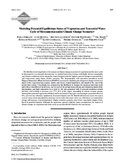| dc.description.abstract | The likelihood and magnitude of the impacts of climate change on potential vegetation and the water cycle
in Mesoamerica is evaluated. Mesoamerica is a global biodiversity hotspot with highly diverse topographic
and climatic conditions and is among the tropical regions with the highest expected changes in precipitation
and temperature under future climate scenarios. The biogeographic soil-vegetation-atmosphere model
Mapped Atmosphere Plant Soil System (MAPSS) was used for simulating the integrated changes in leaf area
index (LAI), vegetation types (grass, shrubs, and trees), evapotranspiration, and runoff at the end of the
twenty-first century. Uncertainty was estimated as the likelihood of changes in vegetation and water cycle
under three ensembles of model runs, one for each of the groups of greenhouse gas emission scenarios (low,
intermediate, and high emissions), for a total of 136 runs generated with 23 general circulation models
(GCMs). LAI is likely to decrease over 77%-89% of the region, depending on climate scenario groups,
showing that potential vegetation will likely shift from humid to dry types. Accounting for potential effects of
CO2 on water use efficiency significantly decreased impacts on LAI. Runoff will decrease across the region
even in areas where precipitation increases (even under increased water use efficiency), as temperature
change will increase evapotranspiration. Higher emission scenarios show lower uncertainty (higher likelihood)
in modeled impacts. Although the projection spread is high for future precipitation, the impacts of
climate change on vegetation and water cycle are predicted with relatively low uncertainty. | es_ES |


